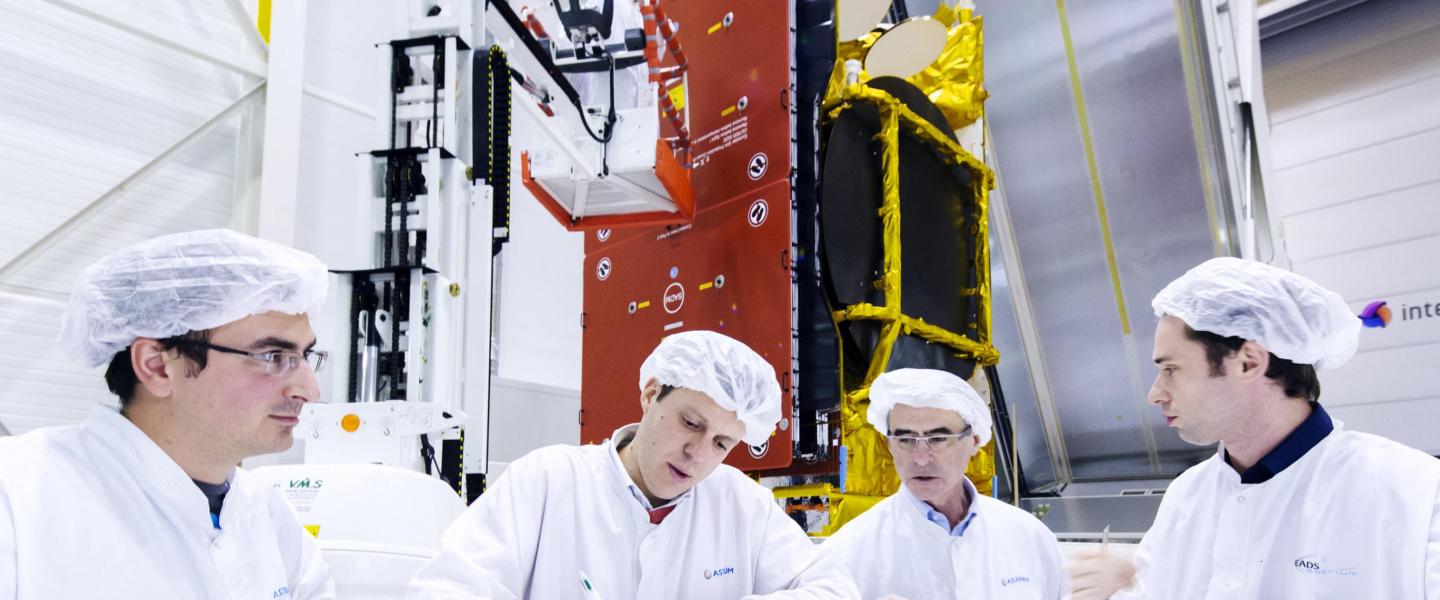Electric Propulsion: Revolutionising the Satellite Industry

The use of electrically charged particles (electrically charged atoms or molecules and electrons) in rocketry is making an enormous difference to the costs of getting a satellite into orbit. The concept is well-established given that the first ideas emerged in the early part of the 1900s by the brilliant Russian rocket scientist Konstantin Tsiolkovsky, and published in his 1911 book “Works on Rocket Technology”. A self-taught genius, Tsiolkovsky is considered one of the ‘fathers’ of the space industry. He claimed that he was inspired by the writings of Jules Verne, and in an episode of Star Trek: The Next Generation (“The Naked Now”) a science ship is named after him.
Konstantin Tsiolkovsky was also very much aware of the basic ‘reaction engine’ concept outlined by Isaac Newton (1643-1727) and his Third Law of Motion, that – in essence – states that for every action there is an equal reaction. “Law III: To every action there is always opposed an equal reaction: or the mutual actions of two bodies upon each other are always equal, and directed to contrary parts,” as translated from Newton’s original Latin text.
The USA’s rocket pioneer Robert H Goddard working independently in 1906 also detailed some of the core concepts of electric propulsion. Goddard wrote his ideas about electric propulsion in a notebook, although not published at the time, although he carried out some very early laboratory experiments in 1916-1917, and filed major patents on the subject in 1913 and 1917.
Rockets have traditionally used chemical propulsion, an easily understood concept and first used by the Chinese (“Fire Arrows”) as early as the 11th Century when they combined saltpetre, sulphur and fine charcoal powder to make a propellant. But what must be remembered is that much of these early non-Chinese scientific pioneers were working in pure theoretical terms, and well ahead of any practical demonstrations of rocketry beyond a few basic experiments by people like Goddard.
Consequently the electric propulsion ideas were truly revolutionary, and these early thoughts were amplified by another early thinker, Hermann Oberth in his important book ‘Ways to Spaceflight’ published in 1929. The electric concept is straightforward, although ideally only for use in the vacuum of outer space.
The very first working electric thrusters (using Ions as a propellant) were built NASA in 1959. NASA carried out these Ion proving flights in 1964 (the SERT, Space Electric Rocket Test) and again with SERT-II in 1970.
In Ion propulsion, electrons are stripped from a gas such as Xenon to give it a net electrical charge. In very simple non-technical terms the Ion engine then accelerates the particles with an electric or magnetic field and blasts them out the back of the various thrusters on board. Ion thrusters are extremely low-thrust compared to a chemical propellant, but are highly efficient in the absolute vacuum of space. The end result means that a satellite’s overall mission would need only carry a small fraction of the propellant a chemically powered vehicle would need to complete a mission that might extend well beyond 15 or more years in orbit.
With the general experience of the past few years it is accepted that an electrically-powered satellite, using electric thrusters, can save about 50% of the weight of a conventional chemically-fuelled satellite.
The appeal of electric propulsion is immediate: as mentioned, it potentially saves launching a vast amount of heavy propellant needed to deliver a satellite from the initial transfer orbit where it is injected by the rocket, to its final geostationary orbit, and then to keep the satellite in the ideal position for transmitting signals back to Earth – a tasks for which propellant requirements can be reduced to as little as several kilograms per year using efficient electric thrusters.
Various types of electric thrusters have been used since the 1970s. Russian, European and American designs and versions have been used, initially some with better results than others. Russia was certainly the first to embrace electric propulsion in a systematic way, and helped restore industry confidence after what had been a few troubled years for the technology.
Of course, operators might still decide to utilise conventional chemical propulsion to move their satellites rapidly from the transfer orbit to their target geostationary orbit.
But modern thinking is that electric propulsion can play an increasingly important role for the industry. The concept still sees chemical propulsion being used to get the rocket off the ground and into its initial low Perigee transfer orbit (which is closest to the Earth) and then - in essence – the electric thrusters take over.
The immediate upside is that the rocket is carrying much less weight in terms of a ‘fuelled’ satellite.
The downside is the low thrust of the tiny electric engines. They are efficient enough, but the time taken to lift a satellite from its low Perigee orbit to its target geostationary orbit will take months, not the few days of an alchemically fuelled combination of rocket plus chemically-fuelled satellite. The 4-6 months or so needed to lift a satellite to GEO orbit by using electric thrusters means there’s no money being earned from the satellite by the operator during this period.
More positively, satellite operators considering electric-thrusters are favouring building and launching their satellites well ahead of their commercial needs, thereby allowing plenty of time to get the craft into position for an efficient hand-over from the ‘old’ satellite to the newcomer.
The other key advantages are all cost-related, and they are significant. Less propellant means much lower launch costs. More efficient electric thrusters can dramatically extend the life of a satellite by years, and an extended life means more cash flowing when the craft’s costs have been wholly amortised.
There’s another quite dramatic benefit of all – electric propulsion: the lower weight in an electric satellite permits much larger satellites to be launched. They can have additional functionality, reaching additional markets, and with much more flexibility in their mission, and yet still be less expensive to launch. This is a convincing ‘win-win-win’ set of options which is revolutionising the industry.
